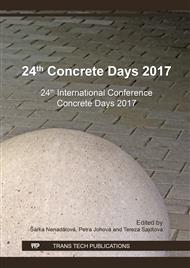p.121
p.127
p.135
p.141
p.147
p.154
p.160
p.166
p.172
Results of Short-Term Experiments with Monostrands in Saddles with Small Radii
Abstract:
When strengthening existing reinforced concrete structures, we can find many successful applications of post-tensioning. The method of substituted cable ducts is a very convenient especially in the case of strengthening existing reinforced concrete bridges whose load capacity can be increased up to 300 %. Strengthening of structures by post-tensioning is based on active influence of internal forces by prestressing force and radial forces that occur in places of bending the unbonded prestressing tendons. Thus, the forces which acts directly on structure in the anchorage areas and in the locations where the prestressing tendons change their trajectory (in saddles) are considered as the effects of prestressing. Saddles are one of the most important structural details of the additional prestressing system. For the purpose of closer examination of the action of monostrand in steel saddles with different radii of curvature, the methodology of experiment was developed and the concrete test panel in which holes for sensors and substituted cable ducts for monostrand are prepared was created. The concrete test panel enables change of the radius of curvature and was designed for analysis of monostrands in saddles with radii of 600, 1000 and 1500 mm. The aim of short-term experiments with monostrands is to determine suitable application of post-tensioning of existing structures with prestressing tendons in HDPE sheaths in saddles with small radii of curvature.
Info:
Periodical:
Pages:
147-153
Citation:
Online since:
February 2018
Authors:
Keywords:
Price:
Сopyright:
© 2018 Trans Tech Publications Ltd. All Rights Reserved
Share:
Citation:


